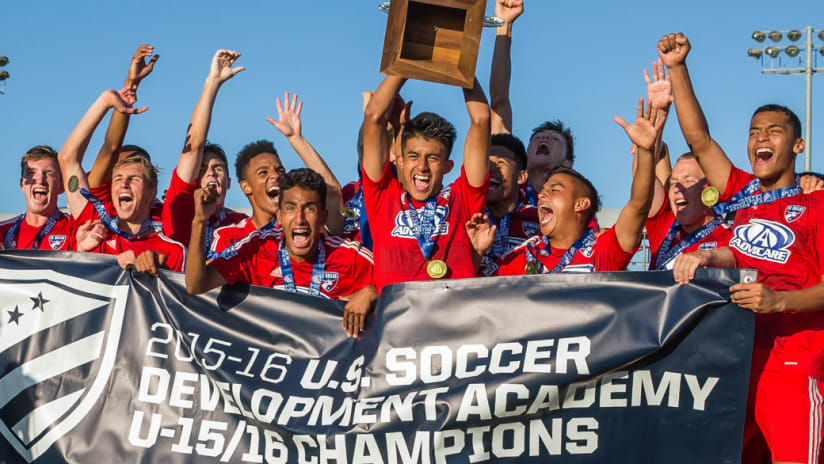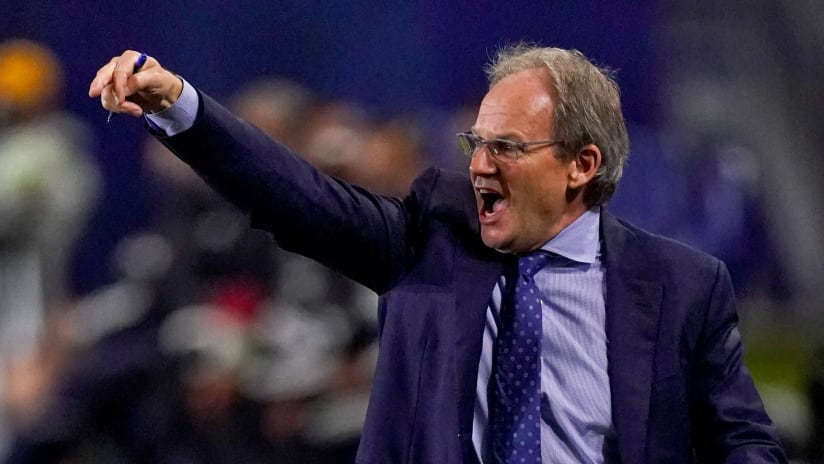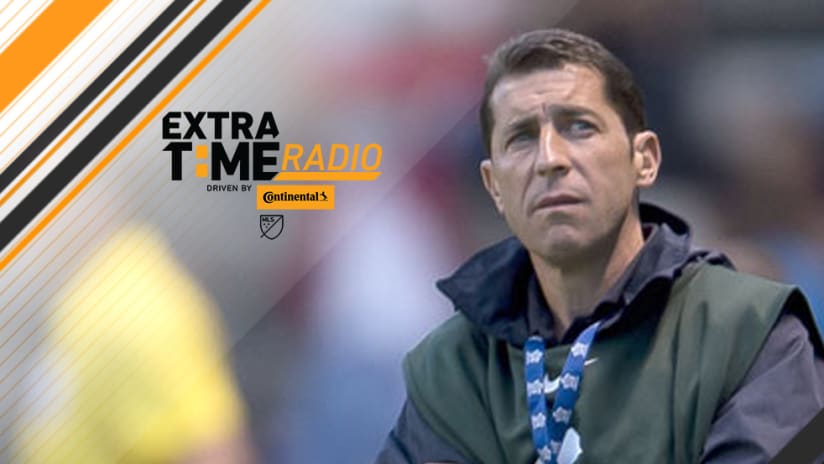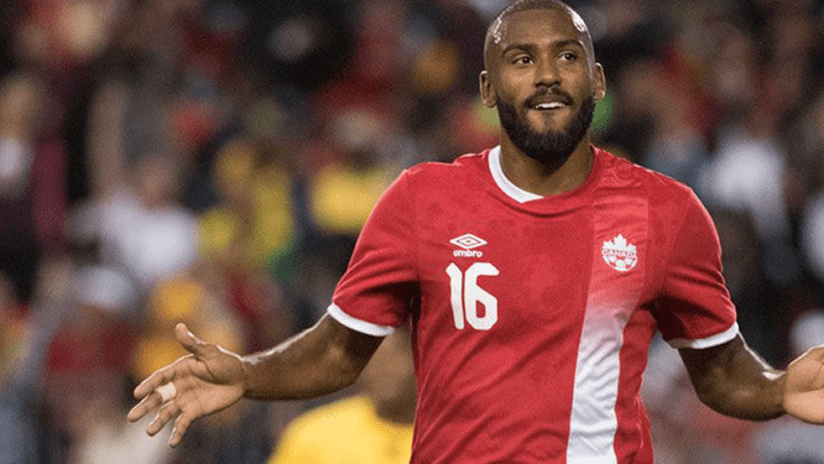Every morning he pulls into work at the Toyota Stadium soccer complex in Frisco, Oscar Pareja follows the same routine.
The former FC Dallas player and current first team head coach always makes a first stop at the soccer fields where the academy players train to say hello to all the players.
Among the familiar faces are Dante Sealy – the U-14 forward and son of former FCD forward Scott Sealy – and Jesus Ferreira, son of FC Dallas great and former MLS MVP David Ferreira. There’s Brandon Terwege, who’s trying to become the first-ever player to win his third national championship and US youth national teamer Brandon Servania.
Pareja does this every day, even with a full workload at the helm of an MLS team on a path to sweeping four trophies this season. That’s because Pareja, FC Dallas president Dan Hunt and the rest of the organization, are committed and invested, both emotionally and financially, in raising their own through the FC Dallas academy.
“Making the kids feel all the time they can have an opportunity, making the coaches in the academy feel like they are part of a complete staff from Under-10s to the professionals – that none of us is bigger than any other,” Pareja told MLSSoccer.com. “And I think with that philosophy, it translates to the players and they can see the whole thing as a unit.
“It’s not just a nice story,” he added. “It’s really what we feel happens here.”
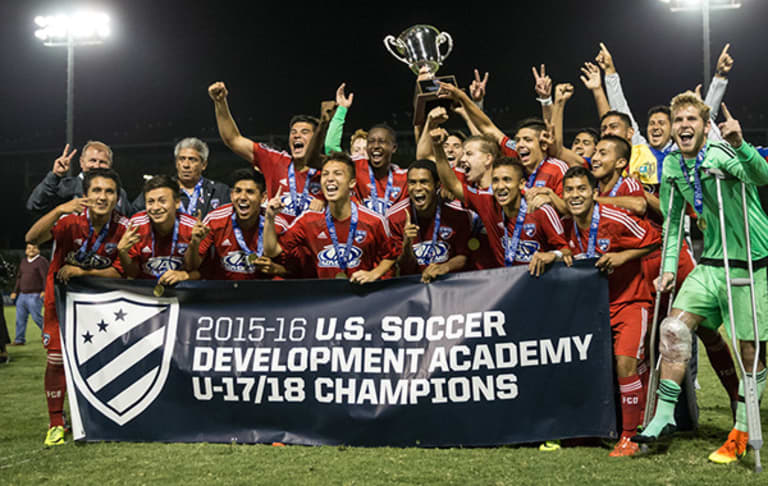
The FC Dallas Under-18 academy team celebrates winning the most recent US Soccer Development Academy title in July 2016. Photo via FC Dallas
“It’s a special time here at the club,” said FC Dallas president Dan Hunt on Sept. 13 after his club vanquished the New England Revolution to claim the 2016 Lamar Hunt US Open Cup.
But he wasn’t just referring to the triumph in the cup competition named after his late father and original FC Dallas owner. In addition to the success on the senior level – FC Dallas have been pacesetters on all fronts throughout the 2016 MLS season – the club has also seen unprecedented success on the academy level with multiple championships and players graduating to the first team.
This year alone, the club’s Under-18 and Under-16 teams brought home national titles to Frisco, and while there was no championship available for the Under-14s, they finished with an undefeated 25-0-2 record. The FC Dallas girls’ academy team – one of just a handful associated with an MLS club – also logged an undefeated season before falling in a tournament quarterfinal.
But what makes the FC Dallas model so successful, according to current academy director and former MLS player Luchi Gonzalez, is that the club prioritizes something other than silverware.
“Winning a championship is an amazing honor for our 15s, 16s or 18s, but our ultimate goal is a day like today where we can sign a player to the first team,” Gonzalez said on the day FC Dallas signed 16-year-old Paxton Pomykal from their academy – their 15th Homegrown player signing in club history. “But that doesn’t happen without a development of the team, which happens within the FC Dallas plan.”
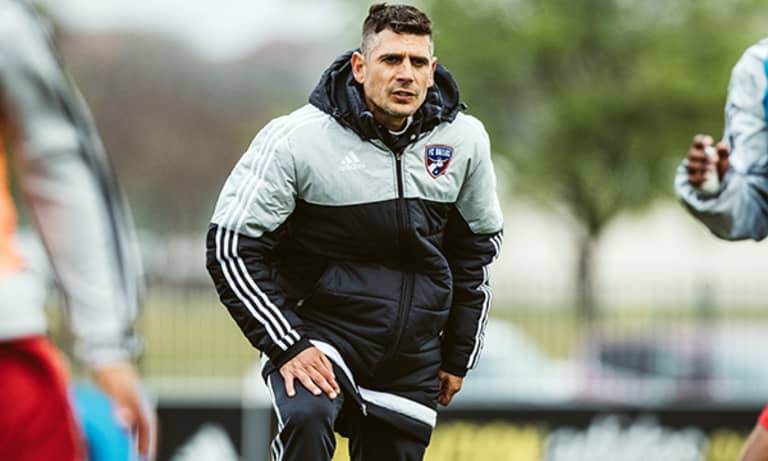
Current FC Dallas academy director and former MLS player, Luchi Gonzalez, directs a training session at Toyota Stadium. Photo via FC Dallas
When they set out to build their farm system in 2008, FC Dallas made it a point to start from the ground up, beginning with teams at the youngest age brackets and building their way up from there. The strategy helped establish FC Dallas as more than just another outlet to play soccer. They were able to inculcate from an early age a culture of love and respect for the club with an entire generation of players.
“[The goal] was to create a community of soccer,” Gonzalez told MLSsoccer.com, “and from that, develop a community of lifelong fans for the club, family members that are going to grow up fans.”
That plan helped establish a sense of family, loyalty and identity that extended from the pro team all the way down to seven year olds who represent the youngest age group in the FCD academy.
“When you can have talent in your club at 10 years old, it’s better than just bringing someone in at U-16 or U-17 where there’s a lot of things that aren’t going to align with your philosophy and training habits,” Gonzalez said. “It’s a lot harder to mold a 16 or 17 year old into your philosophy than it is a 12-year-old or 10-year-old.
“You have that growth with the youth and their connection to the club. But in hindsight, it’s also allowed us to create a bigger player pool,” Gonzalez continued. “It’s allowed us to streamline our talent and have more uniformity from top to bottom.”
But according to just about everyone at FC Dallas headquarters, that uniformity would not be possible without Pareja – the club’s current senior team head coach and the former academy director, who was the original architect.
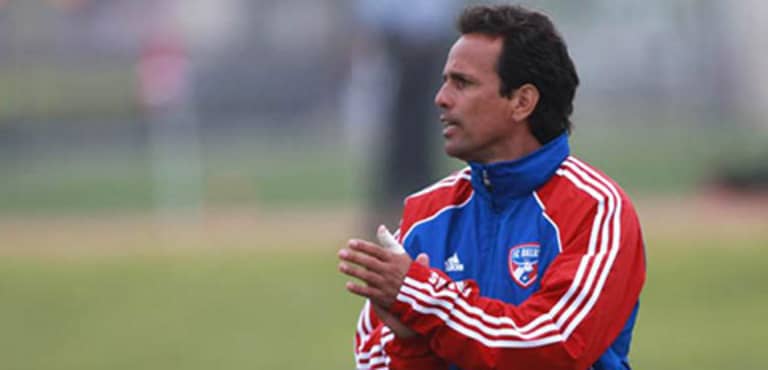
Former FC Dallas player and current head coach, Oscar Pareja, pictured above during his days as Director of Player Development between 2008 and 2011. Photo via FC Dallas
El Profe Makes His Mark
When Dan and Clark Hunt sat down to craft a new long-term strategy for the next phase of the club’s development and carry out the vision of their late father, they knew they wanted to establish a model that encouraged young soccer players to come to Frisco to be part of something groundbreaking and potentially great.
Ultimately the FC Dallas owners tabbed Pareja, a former captain for the club from 1998 to 2005, to execute that vision and they named him Director of Player Development in the academy’s inaugural year in July 2008. He spent the next three seasons building the academy from scratch, working on developing players in a system that was still unproven. And after three years, Pareja had elevated the academy to best-in-class among 70 other programs in the USA, and in the process earning him a reputation as one of the best coaches nationwide and his first senior head coaching job in Colorado.
When it was time for FC Dallas to hire a new head coach for their senior team in 2014 – it only made sense to FC Dallas brass to hire a man who not only had already begun to prove himself as a coach in MLS, but he was also familiar with the youth model that he helped set up years prior.
“The direction of ownership – hiring people who have the same view on how things need to be run and how you’re going to get to the destination you’re trying to go,” technical director Fernando Clavijo said. “I think it’s a leadership you have to take all the way back to ownership with what they want to do and achieve.
“Then, of course, finding people who can execute the plan, which goes to getting a head coach of the first team who really had the same idea on how we were going to develop the players and where we’re going to make them go.”
The idea is simple in concept, but difficult in execution: Create a system in which young soccer up-and-comers believe they can advance their career goals.
To do that, Pareja knew the atmosphere he had to create when he took over as first-team head coach – hence, his morning and afternoon strolls across the fields to learn everyone's name, interact with coaches, and see firsthand how kids are progressing within the FC Dallas model.
Since early 2015, every coach across the organization participates in two staff meetings a week to discuss progress, as well as holding workshops to address what’s working, what isn’t working and generally how to maintain the “FC Dallas Way.”
“We have a training methodology and a model of how we want to play with and without the ball,” Gonzalez said. “We’ve always had documents for it, but it’s been difficult to put into practice on the field. Over the last year and a half or two years, we’ve been very good at implementing our curriculum on the field while still giving coaches autonomy to put their own personality on the team they’re in charge of, but still respecting what the FC Dallas way is and being in line and together.”
With such a meticulous model that trickles down to every age group, the ultimate goal of graduating players to the first team makes for a much more seamless transition.
“Oscar has opened the doors in the integration with the academy and the first team more than anybody else in the league. That is a fact,” Clavijo said. “We’re all engaged in one single idea, which is to develop players and bring them to the first team.”
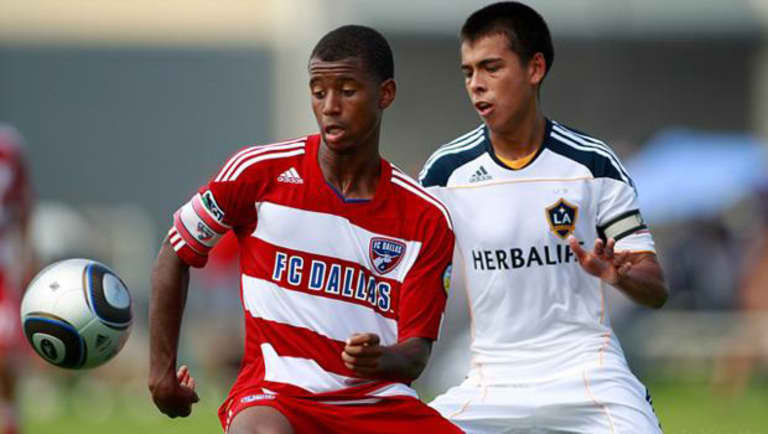
Current FC Dallas midfielder and US national teamer, Kellyn Acosta, pictured above during his time as captain of his FC Dallas academy team. Photo via FC Dallas
Academy Delivers
In the FC Dallas academy’s eight-year history, the club has churned out 15 Homegrown players, ranging from current first-teamers like Victor Ulloa and Kellyn Acosta, to other MLS contributors like London Woodberry (New England Revolution) and Mikey Ambrose (Orlando City), and other players like Richard Sanchez (Mexico) and Jonathan Top (Guatemala) who ply their trade overseas.
A majority of the most recent academy success stories are key members of FC Dallas’ MLS roster with seven players on the current FC Dallas first-team roster. A big reason for the Homegrown presence comes down to Pareja’s initiative to knock down the walls between the first team and the youth sides.
“We had access to the ice tubs, the gym, locker room -- Oscar is always welcoming the [academy] guys with open arms to train with [the first team],“ Acosta told MLSSoccer.com about his time at the academy. “And then me being there, just looking across the field and seeing [first team players], it gave me added motivation to aspire to be just like them.”
Acosta signed with the first team in 2012 as a 16-year-old, as did the most recent Homegrown signing Paxton Pomykal, the team’s 15th Homegrown signee in September 2016, who speaks of a similar experience to Acosta's.
“We trained with the pros pretty much on a day-to-day basis,” Pomykal told MLSsoccer.com. “So for me, I’ve been with them, been in the locker room with them for the past year. So it’s not too much of a change for me compared to someone coming from the outside in. We’re all a family, so I’ve known all these guys for a year and a half and trained with them, and I’ve been comfortable with them for a long time.”
Stories like Acosta’s and Pomykal’s have led to hundreds of applicants to the FC Dallas academy – Gonzalez says there were about 1,000 this spring alone – but not everybody that comes through the academy will be fortunate enough to break through to the first team. Even if they don’t, the FCD model is still designed to reward those who commit to the club.
“Our approach is a total approach here,” Hunt said. “Our academy kids are in early here, they go to school here, they’re here in the afternoons or some evenings they get a chance to train with the first team. They come to our games. If they’re not going to be a professional soccer player, we make sure that college is on the radar for them. So they understand they’re in a place that genuinely cares about them and wants them to be successful, and cares about them as human beings.”
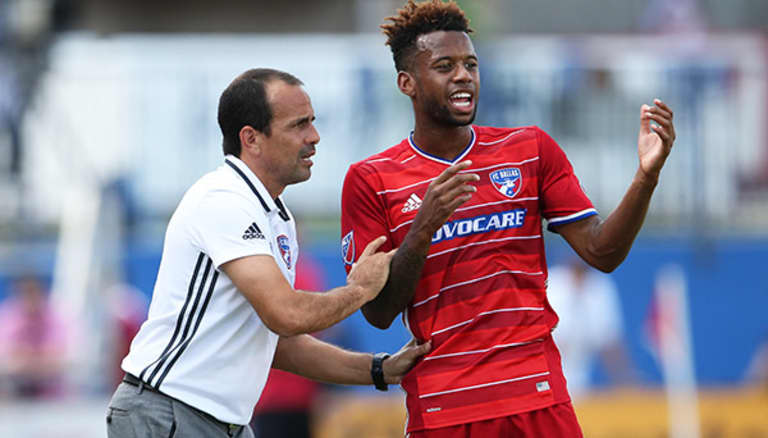
A 21-year-old Kellyn Acosta talks strategy with his FC Dallas head coach Oscar Pareja in a match against Vancouver on July 31, 2016. Photo Matthew Emmons / USA Today Sports Images
Fertile Territory
If you ask Gonzalez, the North Texas region is among the top five in the USA when it comes to local youth soccer talent, behind only Southern California, Northern California, and New York, while rivaling other regions like Chicago, Houston and South Florida.
An important factor in the quality of soccer players developed in North Texas is the Hispanic influence on the game with the Hispanic population comprising 45 percent of the Dallas-Fort Worth (DFW) area.
“That gives you some technical and creative players, even though we do have creative players who aren’t of Hispanic descent,” Gonzalez said. “You get that flair from the Hispanic community. You have athletes with size and speed – you get a little bit of everything. But you also get kids here who are structured, with discipline and who are eager to learn.”
The latter point could help explain why so many young players continue to show they typically have what it takes to graduate to the FC Dallas first team: the youth sports culture in North Texas. Whether it’s high school football under the Texas Friday Night Lights, little league baseball, or youth soccer, youth sports participants in the DFW area are driven to compete and excel. And that push partly comes from parents, some of whom are known to give their seven-year-olds private baseball pitching lessons with former major leaguers.
“The parents here are different than the parents in Ohio, for example – super passionate and competitive, over the top, yelling at games, yelling at refs, yelling at whoever – it's ridiculous,” Gonzalez said. “But if you go to Argentina, it’s the same thing. And Argentina is known for their competitive culture and survival. I think we have a passionate youth sports culture here.”
The local sports culture makes for kids joining the FC Dallas academy who carry that competitive drive and work ethic instilled in them by their parents. That sets the stage for the “FC Dallas Way” to work its magic.
“Talent is one aspect – maybe 20 percent [of a player who can make it to the pros]. The other is attitude and mentality,” Gonzalez said.
A Question of Loyalty
When a club’s academy is producing the professionals and US national teamers at the rate of FC Dallas – 21-year-old Acosta has already featured for the USA in the most recent World Cup qualifiers -- the soccer world will take notice. And it turns out that the MLS club has become a magnet for outside agents and overseas clubs attempting to lure talent.
“It’s a difficult task, because at the edge of 16, 17 when you have many people talking to you and bringing you options, that’s disturbing,” Pareja said. “With agents coming around, it makes it even harder because money gets involved. And that’s not bad, it’s part of the game and part of the life. But the only thing that we can offer to a kid at that moment is loyalty, provide opportunities for them whether with the first team or a good [college] scholarship to wait a little longer until we have a spot on the [first-team] roster for them.”
It’s what happened in the case of top prospect Weston McKennie, who was nonetheless snapped up by scouts for German club Schalke when he turned 18. Today he plays for their reserve team.
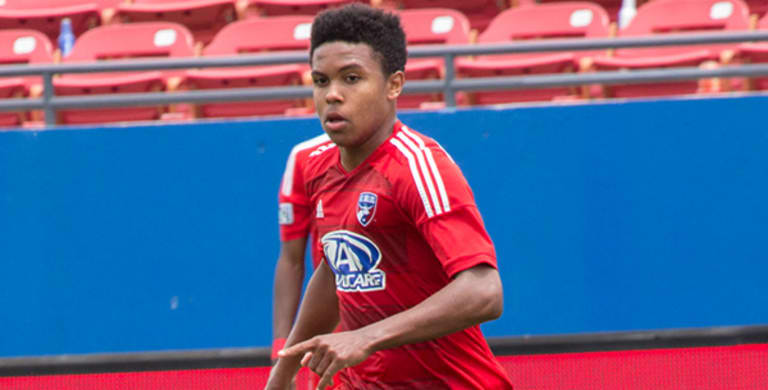
Weston McKennie in action for FC Dallas during an academy match before moving to Germany's Schalke 04 in the summer of 2016. Photo via FC Dallas
To combat cases like McKennie’s, FC Dallas are looking ahead to setting up their own reserve team in the USL, similar to what other MLS clubs have done. That would allow FC Dallas to sign their academy prospects to professional contracts in the USL, where the players would get regular competitive action to continue to boost their development. One source close to FCD said “it’s not a matter of if, but a matter of when,” saying it could happen as early as 2018.
“At some point, we’ll make that plunge and take that opportunity,” Hunt said. “That league is gaining credibility and stature in having success, and I think it’ll be a great outlet for players.”
“We need to find a solution for it, because it’s not working out,” Clavijo said. “But then again, saying that, you have a German team coming in and taking a player from your academy, that shows you our players are good to play anywhere in the world. So really, we don’t want it to happen, but at the same time, it’s something we can show people that they can play not just on our pro team, but anywhere in the world.”
Hunt ultimately believes that the values embodied by the FC Dallas academy will do all the talking for them.
“We have made a commitment for this game to be successful in this country,” Hunt said. “I’m here every day and love what I do, and I think the family environment we have here spills down into our youth system and a lot of these kids grow up and understand that we’re as committed to them and hope they have that commitment back to us.
“It’s never going to be perfect,” he added. “You will lose players periodically, as we lost Weston to Germany. But for every Weston, there’s Paxton or others who are committed to this club. It’s just you have to work with them and build that relationship, and we’ve got the right group of people to do that.”
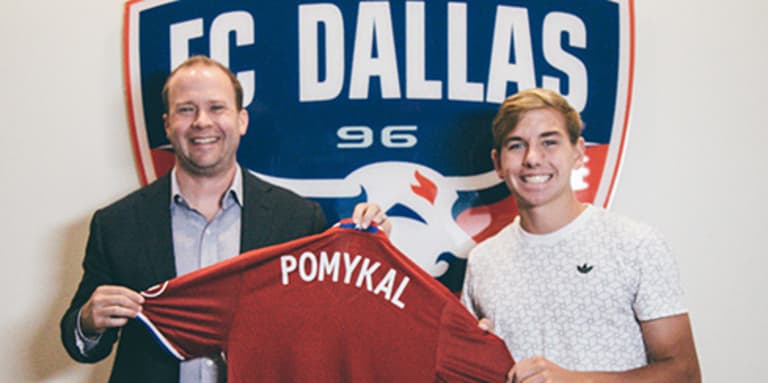
FC Dallas owner and president Dan Hunt poses with the latest Homegrown player academy signing, Paxton Pomykal on the day of his signing in September 2016. Photo via FC Dallas
Looking to the Future
In addition to potentially adding their own USL team by 2018, which would provide playing opportunities that could help keep some academy players in the family in the face of advances from outside competition, FC Dallas have other plans to continue growing the academy.
For starters, Pareja wants to see all of the age groups competing one level higher than they already are (for example, the Under-16’s playing against other Under-18 teams). Meanwhile, Gonzalez also wants to see his teams involved in more international competitions.
Clavijo wants youth players to get out to more MLS league matches to get a first-hand look at how they can improve.
“Seeing Mauro Diaz do a fake in the middle of the field – we cannot duplicate that in training,” he said. “But what they see on the field in Mauro Diaz they may aspire to learn, and that’ll help us more. We’ll develop players differently.”
“We want to keep getting better because everyone else is getting better,” Gonzalez said. “If you sleep for a year, you’ll find yourself five years behind. The game is changing, everyone is investing more in this country, so we want to keep continuing to be the best we can be.”
Ultimately there’s a long-term goal FC Dallas is hoping to achieve: one day fielding an MLS starting XI made up exclusively of Homegrown players. FC Dallas already have the MLS record with five Homegrown players who started in a 2015 win over Columbus Crew SC.
“It’s going to happen at some point,” Hunt said. “I would love for our roster to be at least half Homegrown players. I don’t know if that’ll happen in the near-term, but it’s something I would like to see and strive for. Then you have kids who’ve grown up with you. If it happens, it’ll be a proud day.”

